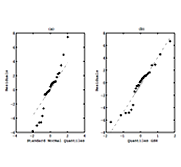Inferencia en modelo de regresión lineal múltiple con errores de distribución secante hiperbólica generalizada
Main Article Content
Keywords
Máxima verosimilitud, Máxima verosimilitud modificada, Mínimo cuadrados, Distribución secante hiperbólica generalizada, Robustez, Prueba de hipótesis
Resumen
Estudiamos el modelo de regresión lineal múltiple bajo errores aleatorios no distribuidos normalmente considerando la familia de distribuciones hiperbólicas secantes generalizadas. Derivamos los estimadores de los parámetros del modelo utilizando la metodología modificada de máxima verosimilitud y exploramos las propiedades de los estimadores modificados de máxima verosimilitud así obtenidos. Mostramos que los estimadores propuestos son más eficientes y robustos que los estimadores de mínimos cuadrados comúnmente utilizados. También desarrollamos la prueba relevante de los procedimientos de hipótesis y comparamos el rendimiento de tales pruebas con las pruebas clásicas que se basan en el enfoque de mínimos cuadrados.
Descargas
Referencias
[2] P. Huber, Robust Statistics, 2nd ed. Jonh Wiley: New York, 1981.
[3] J. Tukey, A survey of sampling from contaminated distributions. Stanford University Press, Stanford: Contributions to Probability and Statistics, 1960.
[4] V. D. Barnett, “Order statistic estimators of the location of the cauchy distribution,” Journal of American Statistical Association., vol. 61, no. 316, pp. 1205–1218, 1966. https://doi.org/10.2307/2283210
[5] D. C. Vaughan, “On the tiku-suresh method of estimation,” Communications in Statistics - Theory and Methods, vol. 21, no. 2, pp. 451–469, 1992. https://doi.org/10.1080/03610929208830788
[6] M. L. Tiku and R. P. Suresh, “A new method of estimation for location and scale parameters,” Journal of Statistical Planning and Inference., vol. 30, no. 2, pp. 281–292, 1992. https://doi.org/10.1016/0378-3758(92)90088-A
[7] D. C. Vaughan and M. L. Tiku, “Estimation and hypothesis testing for a nonnormal bivariate distribution with applications,” Mathematical and Computer Modelling, vol. 32, no. 1/2, pp. 53–67, 2000. https: //doi.org/10.1016/S0895-7177(00)00119-9
[8] M. L. Tiku and A. D. Akkaya, Robust Estimation and Hypothesis Testing, 2nd ed. New York: New Age, 2004.
[9] M. Q. Islam and M. L. Tiku, “Multiple linear regression model under nonnormality,” Communications in Statistics - Theory and Methods., vol. 33, no. 10, pp. 2443–2467, 2004. https://doi.org/10.1081/STA-200031519
[10] D. C. Vaughan, “The generalized secant hyperbolic distribution and its properties,” Communications in Statistics - Theory and Methods., vol. 31, no. 2, pp. 219–238, 2002. https://doi.org/10.1081/STA-120002647
[11] Y. E. Yilmaz and A. D. Akkaya, “Analysis of variance and linear contrasts in experimental design with generalized secant hyperbolic distribution,” Journal of Computational and Applied Mathematics., vol. 216, no. 2, pp. 545–553, 2008. https://doi.org/10.1016/j.cam.2007.06.001
[12] V. D. Barnett, “Evaluation of the maximum likelihood estimator when the likelihood equation has multiple roots,” Biometrika., vol. 53, no. 1/2, pp. 151–165, 1996. https://doi.org/10.2307/2334061
[13] S. Puthenpura and N. K. Sinha, “Modified maximum likelihood method for the robust estimation of system parametrs from very noisy data,” Automatica., vol. 22, pp. 231–235, 1986. https://doi.org/10.1016/ 0005-1098(86)90085-3
[14] B. Senoglu and M. L. Tiku, “Analysis of variance in experimental design with non-normal error distributions,” Communications in Statistics - Theory and Methods., vol. 30, pp. 1335–1352, 2001. https://doi.org/10.1081/ STA-100104748
[15] M. Q. Islam, M. L. Tiku, and F. Yildirim, “Nonnormal regression. I. skew distributions,” Communications in Statistics - Theory and Methods., vol. 30, no. 6, pp. 993–1020., 2001. https://doi.org/10.1081/STA-100104347
[16] M. L. Tiku, W. K. Wong, and G. Bian, “Estimating parameters in autoregressive models in non-normal situations: symmetric innovations,” Communications in Statistics - Theory and Methods., vol. 2, no. 28, pp. 315–341, 1999. https://doi.org/10.1080/03610929908832300
[17] M. L. Tiku, M. Q. Islam, and A. S. Selcuk, “Nonnormal regression. II. symmetric distributions,” Communications in Statistics - Theory and Methods., vol. 30, no. 6, pp. 1021–1045, 2001. https://doi.org/10.1081/ STA-100104348
[18] B. L. Joiner and J. R. Rosenblatt, “Some properties of the range in samples from tukey’s symmetric lambda distributions,” Journal of American Statistical Association, vol. 66, pp. 394–399, 1971. https://doi.org/10.2307/2283943
[19] G. Box, “Non-normality and test of variances,” Biometrika., vol. 40, pp. 336–346, 1953. https://doi.org/10.2307/2333350
[20] M. L. Tiku, W. Y. Tan, and N. Balakrishnan, Robust Inference. New York: Marcel Dekker, 1986.
[21] M. Barrow, Statistics for Economics, Accounting and Business Studies, 5th ed. Pearson Education, 2009.
[22] D. C. Montgomery, E. A. Peck, and G. G. Vining, Introduction to linear regression analysis, 5th ed. John wiley & Sons, 2015

